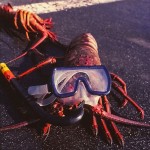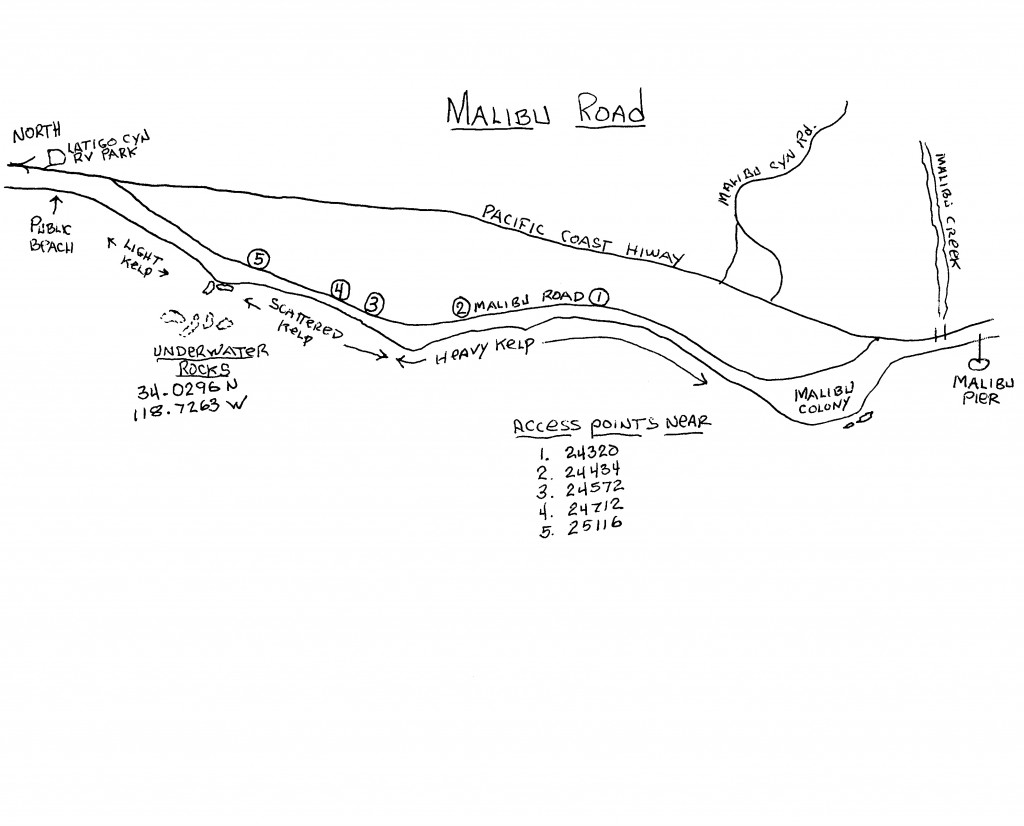 Malibu Road twists along the coast seaward of Pacific Coast Highway with its southern end turning off the main highway about a half mile north of the Malibu Pier and its northern terminus near Latigo Canyon. Beachfront houses block off the majority of the area, but there are several public access gates marked with blue trash cans where beach divers can make their way down to the shore. The nearest boat access is Marina Del Rey, but there are plenty of places to launch kayaks or small skiffs if you have that option available to you. Parking is along the road, mostly on the eastern side where there are fewer homes.
Malibu Road twists along the coast seaward of Pacific Coast Highway with its southern end turning off the main highway about a half mile north of the Malibu Pier and its northern terminus near Latigo Canyon. Beachfront houses block off the majority of the area, but there are several public access gates marked with blue trash cans where beach divers can make their way down to the shore. The nearest boat access is Marina Del Rey, but there are plenty of places to launch kayaks or small skiffs if you have that option available to you. Parking is along the road, mostly on the eastern side where there are fewer homes.
 This stretch of the coastline offers divers several options year around. There’s fair to good lobster hunting in season, numerous halibut from February through October, and calico and sand bass flourish here, too. Most of the larger scallops have been picked over, but small to medium sized shellfish are fairly common around the rockier areas. Beach entry spots vary; you can find parches of sand or gravel and pebbles near most access points. Generally the bottom shelves out gradually, and this part of the coastline isn’t known for rough surf except during stormy weather. Visibility on the bottom varies with the size of the swell. I’ve been here on days when you can see 50 feet, and on days when you can’t see your hand in front of your mask. Generally, you’ll find this part of the coast workable, and as in most areas; it’s clearer in deeper water.
This stretch of the coastline offers divers several options year around. There’s fair to good lobster hunting in season, numerous halibut from February through October, and calico and sand bass flourish here, too. Most of the larger scallops have been picked over, but small to medium sized shellfish are fairly common around the rockier areas. Beach entry spots vary; you can find parches of sand or gravel and pebbles near most access points. Generally the bottom shelves out gradually, and this part of the coastline isn’t known for rough surf except during stormy weather. Visibility on the bottom varies with the size of the swell. I’ve been here on days when you can see 50 feet, and on days when you can’t see your hand in front of your mask. Generally, you’ll find this part of the coast workable, and as in most areas; it’s clearer in deeper water.
Southern Malibu Road
After entering Malibu Road just north of Malibu Pier and driving north, you’ll go past the Malibu Beach Colony where access is restricted for a good half mile. The first gate to the beach is near 24320 Malibu Road. Just north of that point there’s a short piece of sand that makes for an easy entry when the weather is behaving. The best area for lobsters is south where there’s scattered boulders and rocky ledges that support a fairly heavy kelp bed. The outer edge of the rocky terrain breaks into sand at about 40 feet, and that edge is fairly well defined. One can work along that structure for half a tank, and then turn shoreward and come back through the middle ground in about 25 feet of water. There are plenty of places for lobsters to hide, and the sand around the rocks usually hold fair numbers of medium-sized halibut. The bass seem to hang closer to the heavier rock structures, but they’ve seen divers before, and they can be skitterish.
The next access point is further north near 24434 Malibu Road, and the entry there is over sand. You can work north or south here through the offshore patches of rock and kelp. Generally there are more lobsters to the south and more halibut to the north, but sometimes you can be fooled. The rocks aren’t as heavy along here, but they can still be productive. The access point near 25572 Malibu Road is similar to the one just described. This is my least favorite, but we all know that you never know what you’ll find until you look, so it’s worth a dive to form your own opinion. Remember, you can never judge a diving area on one dive. The sea is always in flux, changing over time, and the animals that live there do that, too.
Next week, details on the northern half of the Malibu Road area.
